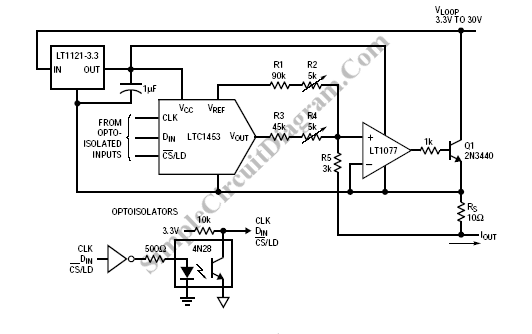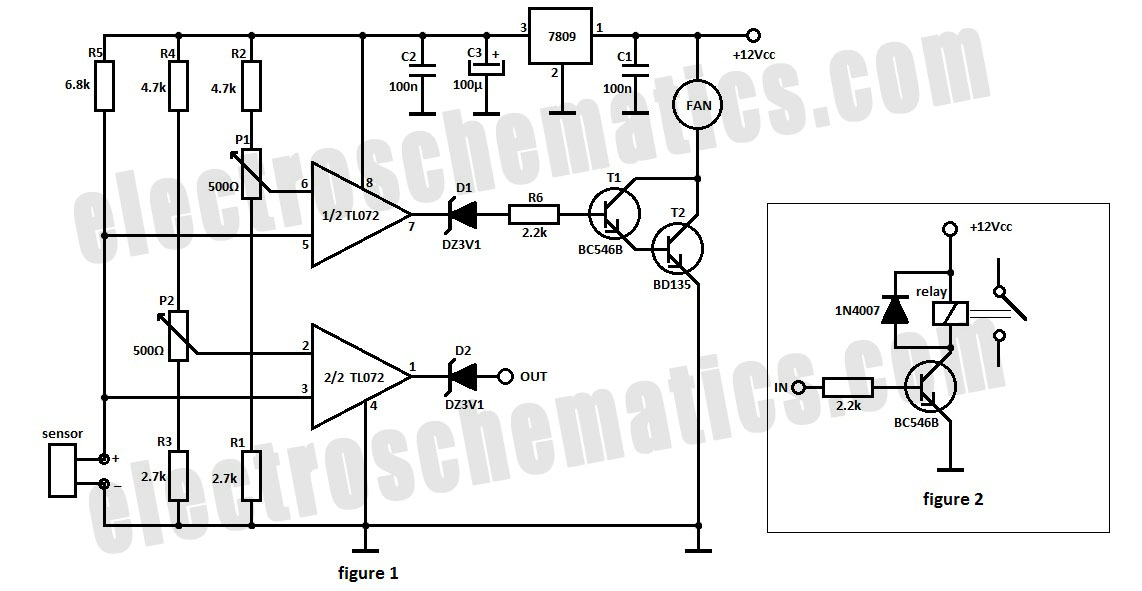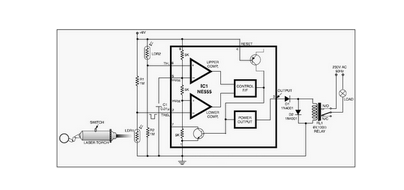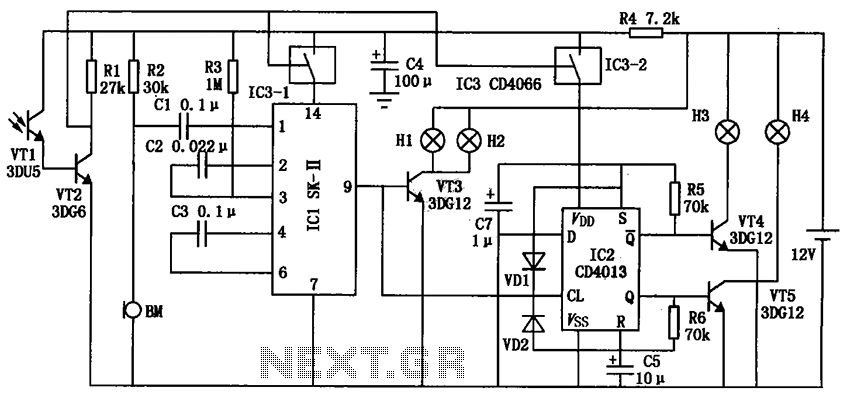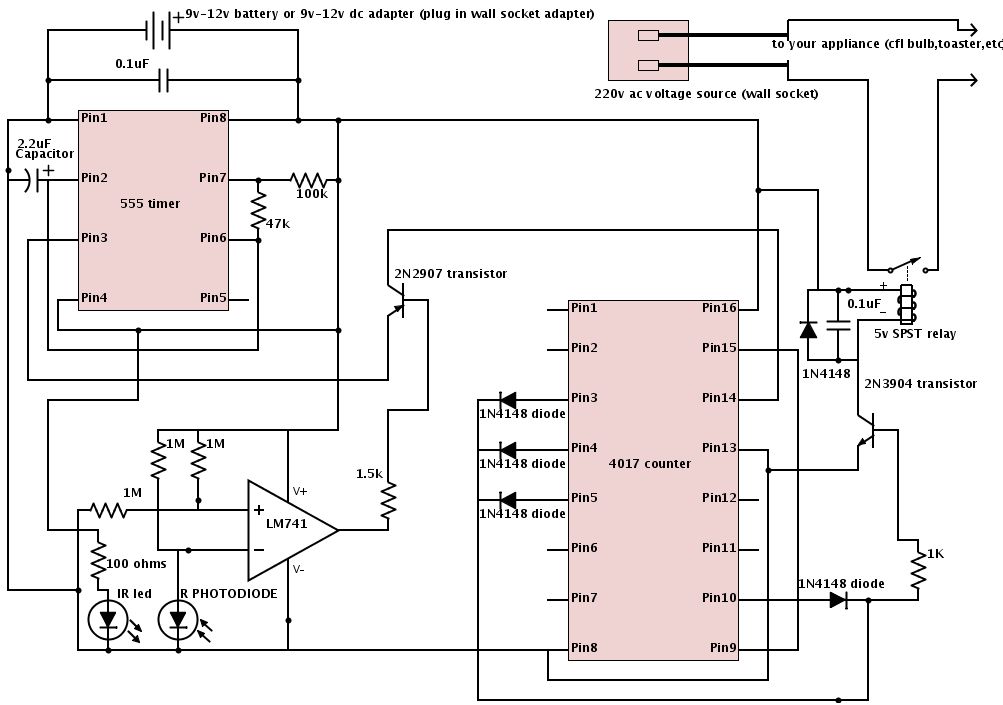
ir remote control home appliance
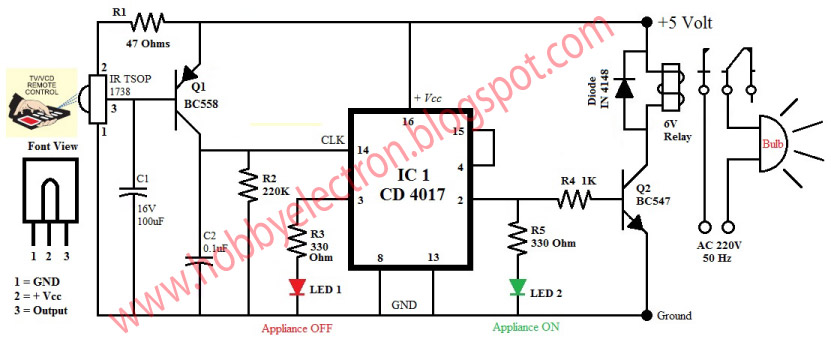
This circuit is a popular infrared (IR) remote control system designed for home appliances such as lamps, fans, radios, and TVs, allowing users to turn devices on or off using a TV, VCD, or DVD remote control. The design is straightforward, requiring only a few components. The circuit can be activated from a distance of up to 10 meters. The 38 kHz infrared signals emitted by the remote control are received by the IR receiver module TSOP1738. Pin 1 of the TSOP1738 is connected to ground, pin 2 is connected to the power supply through a resistor (R5), and the output is taken from pin 3. The output signal is amplified by transistor T1 (BC558), and the amplified signal is sent to the clock pin (14) of the decade counter IC CD4017 (IC1). Pin 8 of IC1 is grounded, pin 16 is connected to Vcc, and pin 3 is linked to LED1 (red), which indicates that the appliance is off. The output from IC1 is taken from pin 2, where LED2 (green) is connected to indicate the on state of the appliance. Transistor T2 (BC548) connected to pin 2 of IC1 drives relay RL1. Diode IN4148 serves as a freewheeling diode. The appliance under control is connected between the pole of the relay and the neutral terminal of the mains. It connects to the live terminal of AC mains via the normally open (N/O) contact when the relay is energized. Any NPN transistor can replace BC548; alternatives include SL100 or any available NPN transistor. The delay in the circuit operation is influenced by the capacitor C1; using a higher value capacitor will create a longer delay, while a lower value capacitor may cause the circuit to switch more than twice when a remote button is pressed. An analysis of the circuit can be performed by substituting a 10 µF capacitor in place of C1 (100 µF).
This infrared remote control circuit utilizes a basic yet effective design, suitable for controlling various household appliances. The heart of the system is the TSOP1738 IR receiver module, which effectively demodulates the incoming 38 kHz IR signals from standard remote controls. The connections to the TSOP1738 are critical: the ground connection ensures proper operation, while the resistor R5 limits the current to pin 2, preventing damage to the module.
The amplified signal from the BC558 transistor plays a vital role in driving the CD4017 decade counter. The CD4017 is a versatile IC capable of counting and driving outputs based on clock pulses. In this application, it serves to indicate the state of the appliance through the red and green LEDs. The red LED (LED1) signifies that the appliance is off, while the green LED (LED2) signals that the appliance is on. This visual feedback is essential for user interaction.
The relay (RL1) acts as the switch for the appliance, allowing it to be powered on or off based on the output from the CD4017. The inclusion of a freewheeling diode (IN4148) is crucial in protecting the circuit from voltage spikes generated when the relay coil is de-energized, thus ensuring longevity and reliability of the components.
Adjusting the capacitance of C1 allows for fine-tuning of the circuit's response time. It is advisable to experiment with different capacitor values to achieve the desired delay and responsiveness. This flexibility in component selection and configuration makes the circuit adaptable for various applications, enhancing its utility in home automation projects.This is the most popular IR Remote control circuit for home appliances like lamp, fan, radio, tv etc to make the appliance turn on/off from a TV, VCD or DVD remote control. It is very simple to build because of few components and simple design. The circuit can activated from up to 10 metres. The 38kHz infrared (IR) rays generated by the remote con trol are received by IR receiver module TSOP1738 of the circuit. Pin 1 of TSOP1738 is connected to ground, pin 2 is connected to the power supply through resistor R5 and the output is taken from pin 3. The output signal is amplified by transistor T1 (BC558). The amplified signal is fed to clock pin 14 of decade counter IC CD4017 (IC1). Pin 8 of IC1 is grounded, pin 16 is connected to Vcc and pin 3 is connected to LED1 (red), which glows to indicate that the appliance is off.
` The output of IC1 is taken from its pin 2. LED2 (green) connected to pin 2 is used to indicate the on` state of the appliance. Transistor T2 (BC548) connected to pin 2 of IC1 drives relay RL1. Diode IN 4148 acts as a freewheeling diode. The appliance to be controlled is connected between the pole of the relay and neutral terminal of mains. It gets connected to live terminal of AC mains via normally opened (N/O) contact when the relay energises.
you can use any NPN transistor inplace of BC548. You can also use SL100 or any NPN transistor lying around you. The delay depends on the C1 capacitor. Using higher value capacitor will create more delay and using less value capacitor will switch the circuit more than 2 times when you press a remote. Analyse the circuit by placing the 10uf capacitor in place of C1 (100uf). 🔗 External reference
This infrared remote control circuit utilizes a basic yet effective design, suitable for controlling various household appliances. The heart of the system is the TSOP1738 IR receiver module, which effectively demodulates the incoming 38 kHz IR signals from standard remote controls. The connections to the TSOP1738 are critical: the ground connection ensures proper operation, while the resistor R5 limits the current to pin 2, preventing damage to the module.
The amplified signal from the BC558 transistor plays a vital role in driving the CD4017 decade counter. The CD4017 is a versatile IC capable of counting and driving outputs based on clock pulses. In this application, it serves to indicate the state of the appliance through the red and green LEDs. The red LED (LED1) signifies that the appliance is off, while the green LED (LED2) signals that the appliance is on. This visual feedback is essential for user interaction.
The relay (RL1) acts as the switch for the appliance, allowing it to be powered on or off based on the output from the CD4017. The inclusion of a freewheeling diode (IN4148) is crucial in protecting the circuit from voltage spikes generated when the relay coil is de-energized, thus ensuring longevity and reliability of the components.
Adjusting the capacitance of C1 allows for fine-tuning of the circuit's response time. It is advisable to experiment with different capacitor values to achieve the desired delay and responsiveness. This flexibility in component selection and configuration makes the circuit adaptable for various applications, enhancing its utility in home automation projects.This is the most popular IR Remote control circuit for home appliances like lamp, fan, radio, tv etc to make the appliance turn on/off from a TV, VCD or DVD remote control. It is very simple to build because of few components and simple design. The circuit can activated from up to 10 metres. The 38kHz infrared (IR) rays generated by the remote con trol are received by IR receiver module TSOP1738 of the circuit. Pin 1 of TSOP1738 is connected to ground, pin 2 is connected to the power supply through resistor R5 and the output is taken from pin 3. The output signal is amplified by transistor T1 (BC558). The amplified signal is fed to clock pin 14 of decade counter IC CD4017 (IC1). Pin 8 of IC1 is grounded, pin 16 is connected to Vcc and pin 3 is connected to LED1 (red), which glows to indicate that the appliance is off.
` The output of IC1 is taken from its pin 2. LED2 (green) connected to pin 2 is used to indicate the on` state of the appliance. Transistor T2 (BC548) connected to pin 2 of IC1 drives relay RL1. Diode IN 4148 acts as a freewheeling diode. The appliance to be controlled is connected between the pole of the relay and neutral terminal of mains. It gets connected to live terminal of AC mains via normally opened (N/O) contact when the relay energises.
you can use any NPN transistor inplace of BC548. You can also use SL100 or any NPN transistor lying around you. The delay depends on the C1 capacitor. Using higher value capacitor will create more delay and using less value capacitor will switch the circuit more than 2 times when you press a remote. Analyse the circuit by placing the 10uf capacitor in place of C1 (100uf). 🔗 External reference

